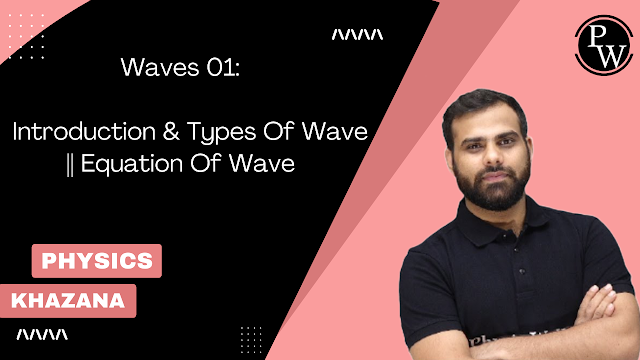Waves || Lecture - 01 || Manish Raj Sir || Class 11 || Physics || NEET
Hello Guys!!! I Assume that You All are Watch Waves - 01 Lecture. Now, Before Going to the Notes I wanna Remind you that Here, we provide Physics Wallah Arjuna NEET Lectures, DPP & ClassNotes.
Manish Raj Sir Lecture
Topic Briefly Discussed
Definition Of Wave
A wave is defined as a disturbance that travels through a medium, transferring energy from one point to another without any net transfer of matter. Waves can be classified into two main types: mechanical waves and electromagnetic waves.
Mechanical Waves:
Mechanical waves are waves that require a medium to travel through. They cannot travel through a vacuum. Examples of mechanical waves include sound waves, water waves, and seismic waves.
Sound waves are longitudinal waves, which means that the particles of the medium vibrate back and forth in the same direction as the wave is propagating. Sound waves require a medium such as air, water, or solids to propagate. The speed of sound waves depends on the properties of the medium through which they are traveling.
Water waves are transverse waves, which means that the particles of the medium vibrate perpendicular to the direction of wave propagation. Water waves are caused by disturbances on the surface of the water, such as wind or objects moving through the water.
Seismic waves are a type of mechanical wave that is generated by earthquakes and other seismic events. They can travel through the Earth's crust and can be used to study the internal structure of the Earth.
Electromagnetic Waves:
Electromagnetic waves are waves that can travel through a vacuum, without the need for a medium. They are transverse waves, which means that the electric and magnetic fields oscillate perpendicular to the direction of wave propagation. Examples of electromagnetic waves include radio waves, microwaves, infrared radiation, visible light, ultraviolet radiation, X-rays, and gamma rays.
Properties of Waves:
Waves have several important properties that are relevant to the NEET syllabus. These include:
Amplitude: The amplitude of a wave is the maximum displacement of a particle from its equilibrium position. It is a measure of the energy carried by the wave.
Wavelength: The wavelength of a wave is the distance between two adjacent points on the wave that are in phase. It is usually represented by the symbol λ (lambda).
Frequency: The frequency of a wave is the number of complete cycles that the wave undergoes per unit time. It is usually represented by the symbol f.
Wave speed: The speed of a wave is the distance that the wave travels per unit time. It is usually represented by the symbol v.
Period: The period of a wave is the time taken for one complete cycle of the wave. It is usually represented by the symbol T.
Wave Equation:
The relationship between the wavelength, frequency, and wave speed of a wave is given by the wave equation:
v = λf
This equation can be used to calculate any one of the three variables, given the other two.
Applications of Waves:
Waves have many important applications in everyday life and in various fields of science and technology. Some examples include:
Medical imaging: X-rays and ultrasound waves are used in medical imaging to visualize internal structures of the body.
Telecommunications: Radio waves and microwaves are used in telecommunications to transmit information over long distances.
Optics: Visible light and other forms of electromagnetic radiation are used in optics to study the behavior of light and to design optical devices such as lenses and mirrors.
Seismology: Seismic waves are used in seismology to study earthquakes and other seismic events.
In conclusion, waves are a fundamental topic in physics and have many important applications in various fields of science and technology. A thorough understanding of waves is essential for students preparing for NEET Exam.




0 Comments